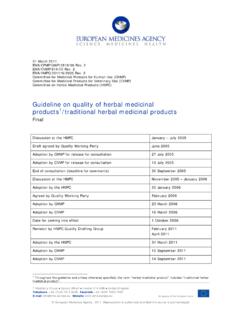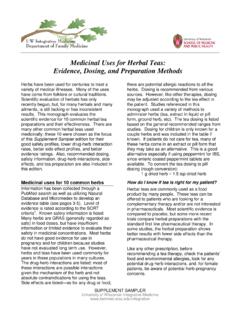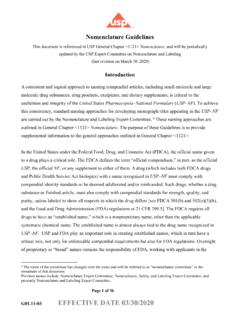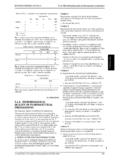Transcription of DRUG NAME: Methotrexate - BC Cancer
1 Methotrexate DRUG NAME: Methotrexate SYNONYM(S): amethopterin,1 MTX COMMON TRADE NAME(S): CLASSIFICATION: antimetabolite Special pediatric considerations are noted when applicable, otherwise adult provisions apply. MECHANISM OF ACTION: Methotrexate is a folate Tetrahydrofolate is the active form of folic acid required for purine and thymidylate synthesis. Folic acid is reduced to tetrahydrofolate by dihydrofolate reductase (DHFR). The cytotoxicity of Methotrexate results from three actions: inhibition of DHFR, inhibition of thymidylate, and alteration of the transport of reduced Inhibition of DHFR results in a deficiency of thymidylate and purines and therefore a decrease in DNA synthesis, repair and cellular The affinity of DHFR to Methotrexate is far greater than its affinity for folic acid or dihydrofolic acid, therefore large doses of folic acid given simultaneously will not reverse the effects of However, leucovorin calcium, a derivative of tetrahydrofolic acid, may block the effects of Methotrexate if given shortly after the Methotrexate since it does not require DHFR for Moderate (> 100 mg/m2) to high-dose Methotrexate (> 1000 mg/m2)
2 4 plus leucovorin rescue is routinely used therapeutically in Cancer Methotrexate is most active against rapidly multiplying cells because the cytotoxic effects occur primarily during the S phase of the cell Methotrexate also has immunosuppressive activity, possibly due to inhibition of lymphocyte PHARMACOKINETICS: Interpatient variability significant differences in time to peak concentration Oral Absorption highly variable and dose dependent5; 60% for doses up to 30 mg/m2; significantly less for doses >80mg/m2 food delays absorption and reduces peak concentration time to peak plasma concentration 1-2 h Distribution actively transported across cell membranes at serum concentrations < mol/mL, mainly passive diffusion at higher concentration5; widely distributed with highest concentration in kidneys, gallbladder, spleen, liver, and skin5; also distributes into third space fluids5 cross blood brain barrier? a ratio of 10-30:1 for CNS concentrations of methotrexate6; higher CNS concentrations noted in patients with recent cranial irradiation and in patients with primary CNS lymphoma due to disruption of the blood-brain barrier volume of distribution L/kg plasma protein binding 50% Metabolism <10%; hepatic and intracellular active metabolite Methotrexate polyglutamates5 and 7-hydroxy-methotrexate7 inactive metabolite 4-amino-4-deoxy-N10-methylpteroic acid (DAMPA)8 Excretion primarily renal via glomerular filtration and active tubular secretion urine 80-90% feces 10% biliary BC Cancer Agency Cancer Drug Manual Page 1 of 16 Methotrexate Developed: September 1994 Revised: August 2006 Limited Revision: 1 August 2017 Methotrexate terminal half life 3-10 h for doses < 30 mg/m2; 8-15 h for higher doses5 clearance decreased at higher doses Children8 more rapid elimination in urine.
3 Greater volume of distribution Adapted from standard reference2 unless specified otherwise. USES: Primary uses: Other uses: *Bladder Cancer Esophageal cancer4 *Breast Cancer Lung cancer4 *Gastric Cancer Testicular cancer4 *Choriocarcinoma *Head and neck Cancer *Leptomeningeal Cancer *Leukemia, acute meningeal *Leukemia, acute lymphoblastic *Leukemia, acute lymphocytic *Lymphoma, Burkitt s *Lymphoma, childhood *Lymphoma, non-Hodgkin s *Mycosis fungoides *Primary unknown Cancer *Sarcoma, lymphatic *Sarcoma, osteogenic *Health Canada approved indication SPECIAL PRECAUTIONS: Caution: Pleural effusions or ascites3: Methotrexate exits slowly from third space compartments resulting in prolonged half-life and unexpected toxicity. In patients with significant third space accumulation, the fluid should be removed prior to treatment and Methotrexate levels should be If the fluid cannot be drained prior to therapy, a dose reduction is Special populations: Elderly patients may be at increased risk for toxicity due to decreased hepatic and renal function, as well as decreased folate A dose reduction as well as monitoring for early signs of toxicities should be Carcinogenicity: Not yet Mutagenicity: Clastogenic in mammalian in vitro and in vivo chromosome Fertility2: Methotrexate can induce a spontaneous abortion in pregnant women especially if given in the first trimester.
4 Methotrexate therapy may result in impairment of fertility, oligospermia, and menstrual dysfunction in humans, during and for a short period after cessation of therapy. Pregnancy should be avoided if either partner is receiving Methotrexate . Males: during and for a minimum of three months after therapy. Females: during and for at least one ovulatory cycle after therapy. Pregnancy: FDA Pregnancy Category D. There is positive evidence of human fetal risk, but the benefits from use in pregnant women may be acceptable despite the risk ( , if the drug is needed in a life-threatening situation or for a serious disease for which safer drugs cannot be used or are ineffective). BC Cancer Agency Cancer Drug Manual Page 2 of 16 Methotrexate Developed: September 1994 Revised: August 2006 Limited Revision: 1 August 2017 Methotrexate Breastfeeding is contraindicated as Methotrexate is detected in human breast Leucovorin rescue4: is required in some Methotrexate regimens.
5 Methotrexate dose: >500 mg/m2 requires leucovorin rescue. 100-500 mg/m2 may require leucovorin rescue. Reference: Bleyer WA. The clinical pharmacology of Methotrexate new applications of an old drug. Cancer 1978; 41: 36-51 Note: micromol/L = 5 x 10-2 micromoles/L Leucovorin dose PO/IV/IM (see Bleyer nomogram): 10-25 mg/m2 every 6 hours for approximately 8 to 10 doses, starting 24 hours after the start of Methotrexate ,10-14 (note: for leucovorin doses >25 mg administer IV).15 Leucovorin dose modifications begin on day 3, if required, based on Methotrexate levels taken that morning ( , level taken 36-48 hours following the start of the Methotrexate infusion). Methotrexate levels are repeated every morning and leucovorin adjusted based on the graph to Continue until the Methotrexate level is < to ,17 The change in threshold concentration from microl/L (as per Bleyer nomogram) to micromol/L is a result of worldwide changes in the immunoassay used to measure Methotrexate serum levels.
6 New laboratory methods have a higher limit of detection than previous methods and inaccuracies have been reported with Methotrexate levels below Note: Leucovorin doses >25 mg should be given IV15 SIDE EFFECTS: The table includes adverse events that presented during drug treatment but may not necessarily have a causal relationship with the drug. Because clinical trials are conducted under very specific conditions, the adverse event rates observed may not reflect the rates observed in clinical practice. Adverse events are generally included if they were reported in more than 1% of patients in the product monograph or pivotal trials, and/or determined to be clinically When placebo-controlled trials are available, adverse events are included if the incidence is > 5% higher in the treatment group. BC Cancer Agency Cancer Drug Manual Page 3 of 16 Methotrexate Developed: September 1994 Revised: August 2006 Limited Revision: 1 August 2017 Methotrexate ORGAN SITE SIDE EFFECT Clinically important side effects are in bold, italics allergy/immunology anaphylaxis (<1%) vasculitis (1-10%) auditory/hearing tinnitus blood/bone marrow/ febrile neutropenia anemia neutropenia: WBC 1st nadir 4-7 days with recovery in 7-13 days; 2nd nadir 12-21 days with recovery in 15-20 days20 thrombocytopenia: platelet nadir 5-12 days with recovery in 15-27 days20 cardiovascular (general) hypotension pericardial effusion pericarditis constitutional symptoms chills and fever (frequent)20 fatigue (frequent)20 malaise (1-10%) mood alteration; with low-dose Methotrexate dermatology/skin extravasation hazard: none21 acne alopecia (1-10%).
7 Usually reversible but may require several months20 dermatitis erythema multiforme (Stevens-Johnson syndrome), exfoliative dermatitis, toxic epidermis necrolysis3 folliculitis furunculosis photosensitivity (1-10%) pigmentary changes (1-10%) pruritus rash (1-10%); on extremities20 reddening of skin (>10%) skin necrosis3 telangiectasia urticaria endocrine diabetes (1-10%) gastrointestinal emetogenic potential22: dose-related: high-moderate for >1000 mg/m2; low-moderate for 250-1000 mg/m2; low for <250 mg/m2 to >50 mg/m2; rare for <50 mg/m2 abdominal discomfort anorexia (>10%) diarrhea (>10%) gingivitis (>10%) BC Cancer Agency Cancer Drug Manual Page 4 of 16 Methotrexate Developed: September 1994 Revised: August 2006 Limited Revision: 1 August 2017 Methotrexate ORGAN SITE SIDE EFFECT Clinically important side effects are in bold, italics glossitis (>10%) nausea; dose-related perforation (>10%)4 pharyngitis stomatitis (>10%) vomiting; dose-related hemorrhage ecchymoses, petechiae hematemesis5 hematuria melena5 hepatobiliary/pancreas pancreatitis hepatic hepatoxicity (1-10%) metabolic/laboratory azotemia; more common with high-dose Methotrexate than with low-dose19 hyperuricemia (>10%) liver function tests, elevated5; usually transient, asymptomatic and return to normal within 10 to 14 days19 musculoskeletal arthralgia/myalgia (1-10%) hemiparesis osteoporosis, fractures; with high-dose methotrexate20 osteonecrosis soft tissue necrosis neurology neurotoxicities (>10%); with intrathecal administration or high-dose Methotrexate cognitive dysfunction, mild transient (<1%); with low-dose methotrexate20 cranial sensations.
8 With low-dose Methotrexate dizziness (1-10%) seizure (1-10%) ocular/visual blurred vision (1-10%) conjunctivitis eye discomfort severe visual changes pain headache20 pulmonary pulmonary toxicity (2-8%)23; can occur with all doses of Methotrexate , although more often with chronic low-dose19 renal/genitourinary renal dysfunction (1-10%); with high-dose Methotrexate secondary malignancy lymphomas; may regress following withdrawal of methotrexate3 sexual/reproductive function abortifacient, fetal defects20 gynecomastia BC Cancer Agency Cancer Drug Manual Page 5 of 16 Methotrexate Developed: September 1994 Revised: August 2006 Limited Revision: 1 August 2017 Methotrexate ORGAN SITE SIDE EFFECT Clinically important side effects are in bold, italics loss of libido/impotence menstrual dysfunction oogenesis, interference with spermatogenesis, interference with vaginal discharge syndromes acute neurologic syndrome (<1%); with high-dose Methotrexate tumour lysis syndrome; especially when given for systemic Burkitt s lymphoma19 vascular cerebral thrombosis deep vein thrombosis pulmonary embolism retinal vein thrombosis Adapted from standard references2,24 unless specified otherwise.
9 Hepatotoxicity: Methotrexate -induced hepatotoxicity can be seen with both high and low-dose Methotrexate , and can be Increased serum aminotransferases (14%) and less commonly hyperbilirubinemia is seen more often in high-dose The liver enzymes can increase with each cycle, and usually return to pre-treatment levels once Methotrexate has been discontinued for 1 Cirrhosis and fibrosis are more often seen with chronic low-dose ,25 See Dosing guidelines for hepatic failure. Patients should be warned to avoid alcohol, prescription medications or herbal supplements that may increase risk of Pulmonary toxicity: Methotrexate -induced pulmonary toxicity can be seen with both high and low-dose Methotrexate , and can be Pulmonary toxicity can be either symptomatic or asymptomatic and can be caused by inflammation, infection or Inflammatory lung disease: most common here is hypersensitivity Pulmonary infections: opportunistic infections due to compromised immune Pulmonary lymphoma.
10 Non-Hodgkin s (B cell) lymphoma which regresses after discontinuation of Methotrexate -induced pulmonary toxicity can be acute, subacute, or Patients who experience pulmonary toxicity will often develop this within the first year of Methotrexate therapy, but it can occur much earlier or much Subacute toxicity is the most common and includes dyspnea, non-productive cough, fever, crackles, cyanosis, pulmonary fibrosis, pleural Treatment includes discontinuing Methotrexate and initiating corticosteroid Improvement can occur within days of stopping Methotrexate ; rechallenging with the drug is not Acute renal failure: High-dose Methotrexate -induced renal failure is a medical emergency because Methotrexate is mainly eliminated by the Renal damage is due to precipitation of Methotrexate in the tubules and to tubule injury. Drug precipitation can often be prevented by hydration and alkalization of the Hydration produces a high urine output and lowers the concentration of Methotrexate in the tubular fluid; alkalization of the urine increases the solubility of Methotrexate .



















